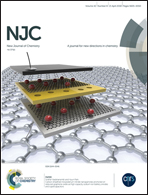Synthesis of tetrahydro-1H-indolo[2,3-b]pyrrolo[3,2-c]quinolones via intramolecular oxidative ring rearrangement of tetrahydro-β-carbolines and their biological evaluation†
Abstract
A simple oxidative ring rearrangement of diversely substituted 1-(2-amminoaryl)-tetrahydro-β-carbolines has been developed to generate architecturally interesting tetrahydro-1H-indolo[2,3-b]pyrrolo[3,2-c]quinolones. This unique transformation involves four reaction centers (aniline, C1-carboline and C2/C3 of indole) and utilizes tert-butylhypochlorite as the reagent. The generic nature of the reaction was demonstrated by the synthesis of a wide variety of analogs 9a–j. A putative reaction mechanism was proposed. Cytotoxicity screening of these compounds against three human cancer cells (A2780 ovarian and HCT116 colorectal carcinoma cell lines and A549 lung adenocarcinoma cell line) revealed selective inhibition of proliferation of the A2780 human ovarian carcinoma cell line by one of the molecules 9a with an IC50 of 14 μM. No cytotoxic activity was observed in human normal fibroblasts for concentrations up to 100 μM. Compound 9a induced hyperpolarization of the mitochondrial membrane potential of the A2780 cell line leading to an increase of reactive oxygen species (ROS) that trigger cell death via apoptosis. Interestingly, compound 9a was also able to induce cell death via autophagy. Compounds that induce apoptosis and autophagy, thus leading to cancer cells’ death, are good candidates for cancer therapy.
![Graphical abstract: Synthesis of tetrahydro-1H-indolo[2,3-b]pyrrolo[3,2-c]quinolones via intramolecular oxidative ring rearrangement of tetrahydro-β-carbolines and their biological evaluation](/en/Image/Get?imageInfo.ImageType=GA&imageInfo.ImageIdentifier.ManuscriptID=C7NJ04616B&imageInfo.ImageIdentifier.Year=2018)


 Please wait while we load your content...
Please wait while we load your content...